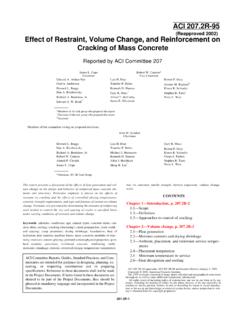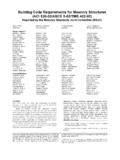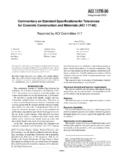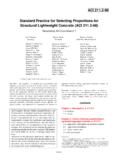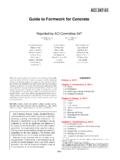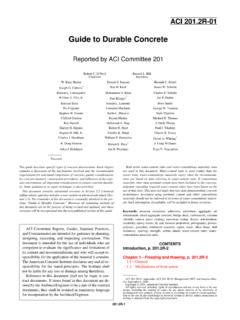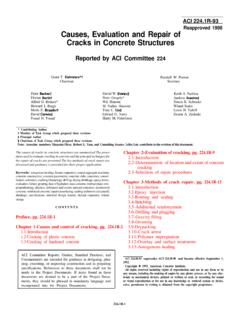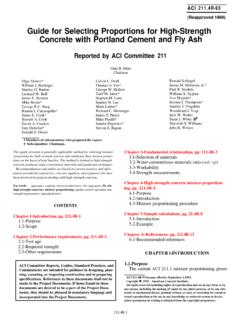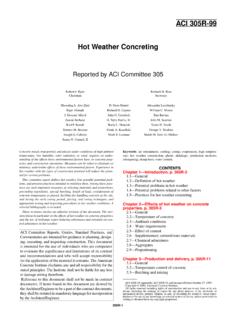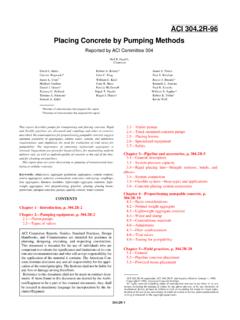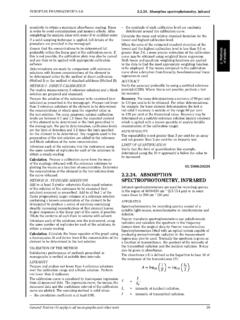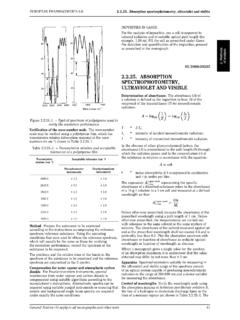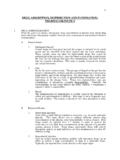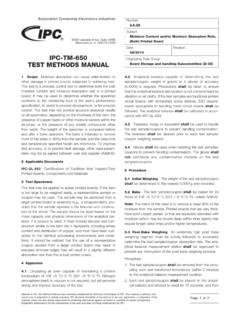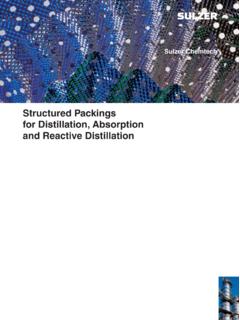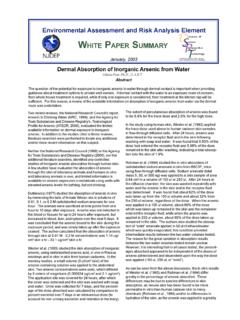Transcription of 207.4R-93 Cooling and Insulating Systems for Mass Concrete
1 Cooling and Insulating Systems for MassACI (Reapproved 1998)ConcreteReported by ACI Committee 207 John M. ScanlonChairmanTerry W. West*Task Group ChairmanFred A. AndersonHoward L BoggsDan A. BonikowskyRichard BradshawEdward BushRobert W. CannonJames L. CopeLuis H. DiazTimothy P. DolenJames R. GrahamMichael I. HammonsKenneth D. HansenMeng K. LeeGary R. MassJames E. OliversonRobert F. OuryErnest K. Schrader*Stephen B. Tatro*l Task group memberThe need to control volume change induced primarily by temperaturechange in mass Concrete has led to the development of Cooling and in-sulating Systems for use in mass Concrete construction. This report reviewsthe development of these system the need for temperature control; pre- Cooling post- Cooling and Insulating Systems currently being used; andexpected trens. A simplified method for computing the temperature offreshly mixed Concrete cooled by various Systems is also thermal elastic shockKeywords: admixtures; cement content; cement types; coarse aggregate; coolingpipes; creep; formwork (construction); heat of hydration; ice; insulation; massconcrete; modulus of elasticity; precooling; post- Cooling ; pozzolans; restraints;specific heat; strains; stresses; temperature rise (in Concrete ); tensile straincapacity; tensile strength; thermal conductivity; thermal diffusivity; thermalexpansion; thermal gradient; thermal shock; thermal 3-Precooling Systems , pg.
2 WaterCONTENTSC hapter l-Introduction, pg. and of construction gains during concreting plant areaChapter 2-Need for temperature control, pg. 4-Post- Cooling Systems , pg. and pumping flow dimensionsChapter 5-Surface insulation, pg. surfacesACI Committee Reports, Guides, Standard Practices, andCommentaries are intended for guidance in designing, plan-ning, executing, or inspecting construction and in preparingspecifications. References to these documents shall not bemade in the Project Documents. If items found in thesedocuments are desired to be a part of the Project Docu-ments, they should be phrased in mandatory language andincorporated into the Project supersedes ACI (Revised 1986) and became effectiveSeptember 1, 8 1993 American Concrete rights reserved including rights of reproduction and use in any form or byany means, including the making of copies by any photo process, or by any elec-tronic or mechanical device, printed or written or oral, or recording for sound orvisual reproduction or for use in any knowledge or retrieval system or device,unless permission in writing is obtained from the copyright ACI COMMITTEE and absorption from light energy requirementsChapter 6-Expected trends, pg.
3 Of aggregate control insulation and precast concreteChapter 7-References, pg. referencesCHAPTER and objectiveThis report presents a discussion of special construc-tion procedures which can be used to control the temper-ature changes which occur in Concrete structures. Theprincipal construction practices covered are precooling ofmaterials, post- Cooling of in-place Concrete by embeddedpipes, and surface insulation. Other design and construc-tion practices, including the selection of cementingmaterials, aggregates, chemical admixtures, cement con-tent, and strength requirements are not within the scopeof this objective of this report is to summarize experi-ences with Cooling and Insulating Systems , and to offerguidance on the selection and application of these proce-dures in design and construction for controlling thermalcracking in all types of Concrete - Historical backgroundThe first major use of artificial Cooling (post- Cooling )of mass Concrete was in the construction of the Bureauof Reclamation s Hoover Dam in the early 1930 s.
4 In thiscase the primary objective of the post- Cooling was to ac-celerate thermal contraction of the columns of concretecomposing the dam so that the contraction joints couldbe filled with grout to insure monolithic action of thedam. The Cooling was achieved by circulating cold waterthrough pipes embedded in the Concrete . Circulation ofwater through the pipes was usually started several weeksor more after the Concrete had been placed. Since Hoo-ver Dam, post- Cooling has been used in construction ofmany large dams. Generally the practices followed wereessentially identical to those followed at Hoover Dam,except that circulation of Cooling water was initiatedsimultaneously with the placement of the early 1940 s the Tennessee Valley Authorityutilized post- Cooling in the construction of Fontana Damfor two purposes: (a) to control the temperature rise par-ticularly in the vulnerable base of the dam where crack-ing of the Concrete could be induced by the restrainingeffect of the foundation, and (b) to accelerate thermalcontraction of the columns so that the contraction jointsbetween columns could be filled with grout to ensuremonolithic action.
5 Post- Cooling was started coincidentlywith the placing of each new lift of Concrete on the pre-viously placed lift and on foundation rock. The pipespacing and lift thickness were varied to limit the max-imum temperature to a pre-designed level in all summer with naturally high (unregulated) placing tem-peratures, the pipe spacing and lift thickness for thecritical foundation zone was ft ( m); in winterwhen placing temperatures were naturally low the pipespacing and lift thickness for this zone was ft ( m).Above the critical zone, the lift thickness was increasedto ft ( m) and the pipe spacing was increased ft ( m). Cooling was also started in this latterzone coincidently with the placing of Concrete in eachnew the 1960 s the Corps of Engineers began the prac-tice of starting, stopping, and restarting the coolingprocess based on the results of embedded resistance ther-mometers.
6 At Dworshak Dam and the Ice Harbor Addi-tional Power House Units, the Cooling water was stoppedwhen the temperature of the Concrete near the pipesbegan to drop rapidly after reaching a peak. Within 1 to3 days, when the temperature would rise again to theprevious peak temperature, Cooling would be startedagain to produce controlled safe use of precooling of Concrete materials to reducethe maximum temperature of mass Concrete was by theCorps of Engineers during the construction of NorforkDam (1941-1945). A part of the batch water was intro-duced into the mixture as crushed ice. The placing tem-perature of the Concrete was reduced about 10 F (6 C).Precooling has become very common for mass concreteplacements. It also is used for placements of relativelysmall dimensions such as for bridge piers and founda-tions where there is sufficient concern for minimizingthermal stresses.
7 For precooling applications variouscombinations of crushed ice, cold batch water, liquidnitrogen, and cooled aggregate were used to achieve aplacing temperature of 50 F (10 C) and in some dams toas low as 40 F ( C).Roller-compacted Concrete (RCC) projects have effec-tively used natural precooling of aggregate. Large quan-tities of aggregate (sometimes all of the aggregate for adam) are produced during cold winter months and placedinto stockpiles. In the warm summer months the exteriorof the piles warms but the interior stays cold. At MiddleFork, Monkesville, and Stagecoach Dams it was not unu-sual to find frost in the aggregate stockpiles during pro-duction of RCC in the summer at ambient temperaturesabout 75-95 F (24-35 C).Precooling and post- Cooling have been used in com-bination in the construction of some massive structuressuch as Glen Canyon Dam, completed in 1963, DworshakCOOLING AND Insulating Systems , completed in 1975, and the Lower Granite DamPowerhouse addition, completed in has been used on lift surfaces and concretefaces which are exposed to severe winter temperatures toprevent orminimize the tendency to crack under suddendrops in ambient temperatures.
8 This method of control-ling temperature changes and the consequent crackinghas been used since 1950. It has become an effectivepractice where needed. The first extensive use of in-sulation was during the construction of Table Rock Dam,built during 1955-57. Insulation of exposed surfaces, forthe purpose of avoiding the development of cracking,supplements other construction control measures, such asprecooling materials and post- Cooling of in-place of cold nitrogen gas into the mixer has beenused to precool Concrete in recent years. Practical andeconomical considerations must be evaluated, but it iseffective. As with ice, additional mixing time may of structuresThese special construction practices have evolved tomeet engineering requirements of massive Concrete struc-tures such as Concrete gravity dams, arch dams, naviga-tion locks, nuclear reactors, powerhouses, large footings,mat foundations, and bridge piers.
9 They are also appli-cable to smaller structures where high levels of internallydeveloped thermal stresses and potential cracks resultingfrom volume changes cannot be tolerated or would behighly objectionable (Tuthill and Adams 1972, and Schra-der 1987). construction practicesIn addition to controlling thermal stresses, mixing andplacing Concrete at temperatures as low as feasible with-out adversely affecting the desired early strength gain willenhance its long-term durability and strength. It will alsoresult in improved consistency and will allow a longerplacing time. The improved workability can, at times, beused to reduce the water requirement. Cooler concreteis also more responsive to vibration during operations can be conducted to achievethese nominal Cooling benefits with only modest extraeffort, and concurrently provide a start toward satisfyingspecific Cooling objectives.
10 Typical construction practicesused to control temperature changes within concretestructures include:l Cooling batch waterl Replacing a portion of the batch water with icel Shading aggregates in storage9 Shading aggregate conveyors9 Spraying aggregate stockpiles for evaporative coolingeffectl Immersion of coarse aggregatesl Vacuum evaporation of coarse aggregate moisturel Nitrogen injection into the mixl Using light-colored mixing and hauling equipmentl Placing at nightl Prompt application of curing waterl Post- Cooling with embedded Cooling pipesl Controlled surface coolingl Avoiding thermal shock at form removall Protecting exposed edges and comers from excessiveheat monitoring of Concrete components dur-ing handling and batching, and of the fresh concretebefore and after its discharge into the forms, can beadequately accomplished with ordinary portable ther-mometers capable of 1 F ( C) resolution.
